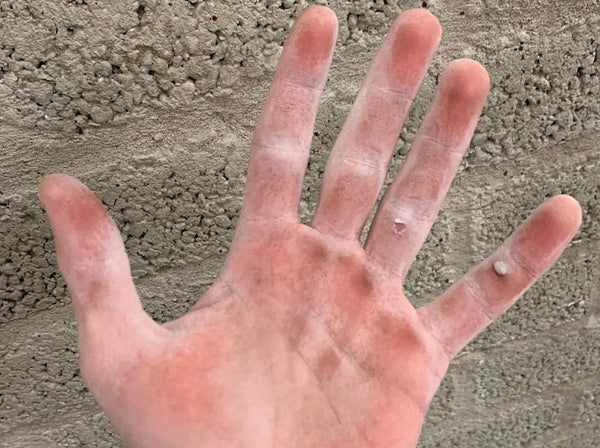How to Heal Your Hands from Rock Climbing?
Introduction: Calluses are the result of low tissue oxygenation due to pressure caused by work tools, weight lifting, rock climbing, or even musical instruments, where certain places of the hands after constant stimulation create a kind of 'protective layer', which makes the skin thicker.
The most suitable way to remove the hard callus skin of calluses yourself is through exfoliation, which can be done initially using the callus performance remover tool and then an exfoliating cream on the callus site. Next, you should apply a moisturizer to the skin to keep the skin soft and silky, which also helps prevent infection.
You can use callus performance healing salve to the wound which helps in healing your calluses faster. Because it is made with organic and natural products like organic coconut oil, vitamins, beeswax, shea butter, etc. All these are powerful antioxidants that protect cuts with anti-microbial and fungal properties. In addition, it helps in reducing irritation, redness, and inflammation too.
How to Heal Your Hands from Climbing?
Rock climbing is a fun activity for everyone, but it can be hard on your hands. Even a light session can cause raw skin and sore muscles and calluses With a few basic tips you can heal your callus hands.
Basic Steps to Heal your hands from climbing
1. Treatment of Pain and Calluses:
- Wash your hands as soon as you finish climbing. Any chalk and plaster on your hands from climbing will dry out your skin and could cause infections. As soon as possible after climbing, wash your hands thoroughly with mild soap and warm water. Then dry them with a clean towel. You will pick up a lot of bacteria while you are climbing, and the residue on your hands can trap these bacteria. That's why hand washing is so important.
- File your corns or calluses to keep them smooth and flat. Most climbers accumulate calluses very quickly, which is a good thing. However, calluses that stick out can get caught in the rock and tear, leading to serious injury. After each climbing session, take a look at your hands and find calluses that stick out.

- Use the callus performance remover tool to file the calluses so that it gets flat. Remember that you don't need to completely remove the calluses because you need them to protect your hands. Just clean your hands enough so that the corn or calluses lay flat and don't get caught in anything.
- Apply callus performance healing salve to your fingertips to hydrate your skin. Keeping your skin hydrated helps prevent cracks and cuts. After washing hands and filing apply healing salve into rough spots and calluses on your hands to help them heal. Repeat this treatment to treat raw or painful calluses skin effectively.
You can get your callus performance healing salve through the online store of Callus performance. Remember, it does not prevent calluses from forming. Since calluses protect your hands, you may actually want them to form if you plan to climb often.
- Soak your hands in ice water to treat pain due to climbing. It's natural for your skin and muscles to get a little sore after a climbing session. A good home remedy for this is a cold water bath. Put some ice and water cubes in a bowl and soak your hands for a few minutes. This helps to calm the pain and encourages your muscles to heal.
2. Caring of Cut and Flakes
Stop climbing if you have a cut or crack in your hand. Any cuts while climbing are potentially serious, so don't try to climb with open callus wounds. Keep an eye on your callus hands while you're climbing. If you see any cuts or cracks of callus, or experience sharp pain, stop and get it fixed immediately.
- Stopping to treat a wound is especially important if you are bleeding.
- Wash the cut as best you can. If you are near a bathroom, then go wash the cut with soap and water. If it's in the middle of nowhere, then wash the wound with some water from your bottle, if you have it. Do your best to remove any dirt from the wound.
- Remove loose skin from a Callus Performance Remover Tool.A flapper is a nasty injury that happens when a piece of your skin gets caught in a rock and peels back to make a flap fence with the name on it. The best way to treat a flapper is to trim loose back skin. Use a callus performance remover tool to cut the flap as far back as possible, cutting through the dead skin. Then wash the wound again to prevent infection.
- Rest your hands until the skin heals. Flakes, cuts, or cracks take some time to heal, and will only get worse if you continue to rise. It's best to heal the wound for at least a few days. You can hit rocks again when you're healed.
- Stay hydrated to keep your skin hydrated. Your skin is more vulnerable to cracking and tearing when it's dehydrated, so make sure you stay hydrated throughout your session.
- Eat plenty of omega-3s in your daily diet. Omega-3s are responsible for fighting inflammation and moisturizing your skin. A diet rich in these nutrients could make your skin stronger and more resistant to climbing injuries. Eat lots of fish, nuts, seeds, and vegetable oils to get your daily dose of omega-3s.
Conclusion: You can heal the hand calluses you get from rock climbing by following the above-mentioned basic callus care tips. For more information, you can contact us freely.


